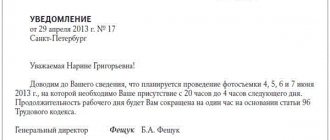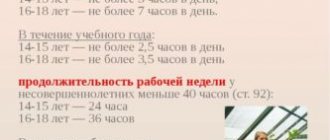What is a work-rest schedule?
The work and rest regime is a system that involves periodic change of these two periods. Their timing and rotation order are regulated at the state level.
Important! The creation of a normal regime is required to maintain human health and ability to work.
Proper organization of the work process is a labor-intensive process. The schedule is drawn up by a labor protection specialist, as well as the organization’s management.
Break at work
Rest breaks
In order to maintain sustainable human performance, the work and rest regime must include micro-breaks. According to current standards, they should not be less than 9-15% of production time. The work and rest schedule of an enterprise necessarily includes regulated breaks not only for rest, but also for a person’s personal needs. Their number and duration directly depend on the specifics of the work.
So, it is important to give employees a short rest an hour before lunch and the same time before the end of the working day. The duration of such regulated pauses is usually 10-15 minutes. Also, during the period of greatest decline in performance, a person should take a ten-minute break for personal needs. The work and rest schedule for people performing heavy work should include hourly five-minute breaks.
As for the lunch break, it should be arranged in such a way that the working day is divided in half. The duration of rest for meals ranges from 40 to 60 minutes. During this time, the person completely restores his physiological functions. All breaks provided by the management of the enterprise must be fixed in the work schedule. In this case, it is necessary to adhere to certain rules. Thus, the total time allocated for rest when performing heavy work can range from 4 to 20 percent. If an employee is forced to be under nervous tension, then this figure increases to 14-25%. People in mental professions are given breaks within 10% of the entire working day.
It is worth saying that regulated rest is the most effective. Irregular interruptions, as well as random downtime, only disrupt the normal rhythm of work.
General rules of work and rest schedule
Work and rest schedule for drivers
Working time - (as defined in Labor Code Article 91) is a time period for the performance of work duties that are determined by the contract or in the job description. It additionally includes:
- forced downtime;
- shift change;
- business trip, as well as travel time to the destination;
- lunch break (if it is not possible to leave the workplace);
- a break in cold weather for employees working in the loading area.
A standard working week consists of 40 hours, but for individual professions, hours are calculated in total for a month, quarter or year.
Workers from different fields
Also, the Labor Code of the Russian Federation indicates the categories for which a shortened program is defined:
- for those working in hazardous working conditions – up to 36 hours;
- for workers in the field of medicine and pedagogy, scientists - also 36 hours;
- for disabled people of groups 1 and 2 – up to 35 hours;
- for teenagers 14-15 years old – maximum 24 hours. For teenagers 16-18 years old – 36 hours.
Important! In some situations, management is required to work overtime. This requires the written consent of the worker (except for emergency situations described in the Labor Code). It should not be more than 4 hours in 2 days with a proportional hourly rate. A maximum of 120 hours are available per year.
Rest and its norms are also described in the Labor Code, Art. 106. This is a period of time during which a person is relieved of his duties and also has the right to use his free time as he wishes.
Article 107 outlines the main periods of rest:
- lunch break, which lasts from 30 minutes to 2 hours according to the decision of production management;
- daily rest, which lasts from the end of the work shift until the start of the next one;
- weekends lasting at least 42 hours. This is a continuous vacation. In some organizations, time is set individually, based on the work schedule;
- public holidays;
- annual paid leave (28 calendar days);
- days of additional leave are assigned to employees with irregular schedules, workers in VUT or in the Far North, and participants in the liquidation of consequences at the Chernobyl nuclear power plant.
The issues of organizing work and rest for enterprise workers are important for the scientific organization of labor.
Work and rest schedule
– regulated duration and alternation of periods of work and rest, established depending on the characteristics of labor processes, ensuring the maintenance of high performance and preservation of the health of workers.
The legislative framework for regulating work regimes (working hours) and rest for enterprise employees is reflected in sections IV and V of the Labor Code of the Russian Federation (hereinafter referred to as the Labor Code of the Russian Federation). According to Article 91 of the Labor Code of the Russian Federation, working hours
– the time during which the employee, in accordance with the internal labor regulations and the terms of the employment contract, must perform labor duties.
Any working time regime
in accordance with Article 100 of the Labor Code of the Russian Federation must include the following components:
– length of the working week, highlighting the form of organization of the labor process (five-day with two days off, six-day with one day off, working week with days off on a sliding schedule, part-time work week);
– work with irregular working hours for certain categories of workers;
– duration of daily work (shift);
– start and end time of work;
– time of breaks in work;
– number of shifts per day;
– alternation of working and non-working days, which are established by internal labor regulations or a collective agreement (employment contract).
A special work schedule includes irregular working hours
, in which individual employees, by order of the employer, if necessary, can be occasionally involved in the performance of their labor functions outside the working hours established for them.
, a flexible working time regime can be established by agreement between the employer and the employee
, within which the start and end times, as well as the total duration of working time, are determined.
In cases where the duration of the production process exceeds the permissible duration of daily work, as well as in order to more efficiently use equipment and increase the volume of output, shift work
(work in two, three or four shifts). When working in shifts, each group of workers must work within the established working hours in accordance with the shift schedule.
In those jobs where, due to the special nature of the work, as well as in the production of work, the intensity of which is not the same throughout the working day (shift), the working day can be divided into parts
so that the total working time does not exceed the established daily work duration.
Time relax
(Article 106 of the Labor Code of the Russian Federation) is the time during which the employee is free from performing work duties and which he can use at his own discretion.
Types of rest time
are enshrined in Article 107 of the Labor Code of the Russian Federation, these are: breaks during the working day (shift); daily (between shifts) rest; weekends (weekly uninterrupted rest); non-working holidays; vacation.
The need to alternate work and rest during different time periods (shift, week, month, year) has a physiological justification. The dynamics of performance during the listed periods of time are not stable. The dynamics of human performance include:
• Processing period
(increasing performance), that is, restoration of work skills, coordination of movements, entering the pace and rhythm of the process (duration from several minutes to 1.5 hours or more). Reducing this period is possible by improving the organization of the workplace and its maintenance.
• Period of stable performance
characterized by a high and stable pace of work performance, a relatively low degree of intensity of human physiological functions.
• Period of decreased performance
occurs as a result of increasing fatigue and manifests itself in a decrease in labor productivity, a slowdown in the pace of work, and a deterioration in the functional state of the employee. A more flexible approach to determining the start time of the lunch break, its duration and the introduction of regulated breaks before the onset of this phase will make it possible to delay the onset of fatigue as much as possible.
Work and rest schedule for workers
Work and rest schedule of truck drivers, latest news
The following modes can be named: intra-shift, daily, weekly, annual.
Scheduling
Intra-shift mode
Such a schedule is created taking into account the phases of human biological activity. When compiling, specialists rely on the samples enshrined in the Labor Code, on the dynamics of fatigue and strength gain. All these changes affect the determination of the number, time and duration of breaks, as well as the start and end times of the work shift.
Additional determining factors:
- field of activity;
- type of work;
- public transport schedule.
Daily regime
This is a cyclical chart. The alternation of shifts is determined by the natural division of the day, namely into morning, afternoon, evening, night. It should be noted that the night shift is often shorter than the day shift. This is due to rapid fatigue and a large number of mistakes made by workers at night.
Important! When establishing a daily routine, workers are guaranteed a minimum between-shift rest of 16 hours.
Weekly (monthly)
The regime assumes an unequal number of weekends and working days for a specific period. When organizing a schedule, a strict number of shifts, their start and end dates are established. With this option, the personnel work in the same composition, and when changing shifts, proper rest is guaranteed.
Annual mode
The 1-year schedule is based on planning a long period of weekends and working days, dependent on annual and additional leave. When creating a schedule, the specifics of the production process, as well as the wishes of the team, are taken into account.
Intra-shift mode
The problem of optimal use of labor time is solved taking into account the specifics of the enterprise. In this case, different types of work and rest regimes can be developed. Among them: shift and monthly, daily and weekly, as well as the longest - annual. Let's consider the first of them.
The intra-shift work and rest schedule for workers has clear regulations. However, it is limited by the start and end time of the performance of official duties. The shift work schedule indicates the exact time of the lunch break, as well as the frequency and duration of rest breaks.
The daily work and rest schedule depends on the specifics of the work performed. So, if a person’s profession requires him to exert little physical effort and little nervous tension, then two breaks are arranged during the shift. One of them starts 2 hours after the start of work and lasts five minutes. The second break is arranged before the end of work (an hour and a half before). Its duration is also 5 minutes.
The daily routine of work and rest at work requiring moderate physical effort or with moderate nervous tension is somewhat different. In this case there are also two breaks, only their duration is 10 minutes. One of them is arranged after the employee has performed his duties for the first one to one and a half hours. A person can take a second break no earlier than two hours before the end of the shift.
A more gentle regime of work and rest is provided for those who work with great physical effort (this applies, for example, to harvesting crops) or under conditions of nervous overload. In such cases, five-minute breaks are arranged for people after the first and second hours of work. Meal time begins 2.5 hours after the start of work. A fourth break is provided for such work. It lasts five minutes and starts an hour after lunch. The fifth break is longer. After 2.5 hours have passed since eating, a person can rest for 30 minutes. Also, this mode of work and rest includes time for dinner. This break lasts 30 minutes. The seventh break in work for people making great physical efforts is provided for an hour before the end of the shift. It lasts 10 minutes.
The work and rest schedule of drivers has special specifics. People in this profession are given a two-hour break in the middle of the working day to eat, which must begin no later than 4 hours after the start of work.
It is worth keeping in mind that the work schedule should not be violated. It is not allowed to transfer all provided breaks to the end of the shift, and therefore the earlier departure of the employee. It should also be remembered that excessively long pauses during the working day, ranging from 30-40 minutes, disrupt the work environment. After them, additional time will be required for the person to “get involved” in the production process.
Driver work schedules
Work and rest schedule for truck drivers according to tachograph
The schedule includes periods not only of travel, but also other intervals:
- mandatory 15-minute rest every 4 hours. Longer rest periods are expected for intercity flights;
- medical pre- and post-trip diagnostics;
- presence of vehicles in the loading and unloading area;
- cargo security;
- troubleshooting car problems.
Driver job
Important! The standards are mandatory for taxis, freight transport and public transport workers (including trains).
A vehicle driver can work 10 hours a day. This is enshrined in law. If necessary, the period can be extended by an additional 2 hours (if the truck driver needs to get to the parking lot, as well as for city and intercity trips). The maximum permissible time per week is 56 hours.
Mandatory breaks are provided:
- for lunch from 30 minutes to 2 hours;
- rest between shifts. Its duration is calculated based on the shift worked (2 times longer);
- weekends (at least 42 hours). They are provided before or immediately after the inter-shift break (i.e. these intervals are summed up).
The mode is recorded in the road log and corresponds to the data from the tachograph. The schedule must be drawn up monthly.
Governing legislation
The legal document that can be referred to is the Labor Code of the Russian Federation. The chapters on the topic under consideration occupy a significant amount of space.
Chapter 16 covers the basics of working hours and scheduling principles. The articles in this chapter provide information about regulations as well as accounting options.
Section 5, Chapter 18 examines the main points of mandatory breaks for workers, namely:
- lunch breaks;
- breaks for heating and rest;
- recommended time for organizing rest during the week;
- weekends and holidays.
The topic of vacations occupies a significant part and is described in detail in Chapter 19.
The work schedule of car drivers is considered separately. The standards are determined by order of the Ministry of Transport, but they do not contradict the Labor Code of the Russian Federation.
https://youtu.be/XZOi2sMnpFA
Types of rest time
Rest time is the period during which an employee is not engaged in performing work functions.
Includes:
- a break during a working day or shift;
- daily rest;
- weekend;
- non-working holidays;
- vacation.
Labor efficiency depends on the quality of workers' rest, since tension and fatigue reduce the level of performance.
Thus, the main task of organizing work time regimes is to reduce downtime, loss of work time, optimize labor, increase efficiency while increasing employee satisfaction with the organization of work processes, and as a result, increase the performance of each worker in the organization.










